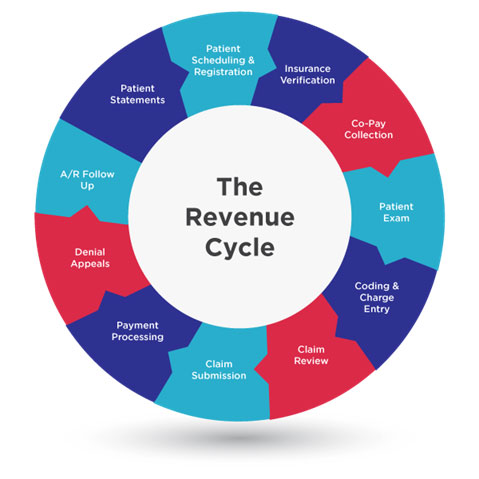Revenue Cycle Management & Claims Followup
Revenue Cycle Management
Revenue Cycle and Profit margins are the lifeline of medical services. The health and success of your services is proportionate to the efficiency of your revenue cycle. CORE OBJECTIVE offers you skilled resources that specialize in accounts receivable as well as denial management.
Extensive knowledge and experience of medical billing across multiple specialties, multiple platforms and various insurances & denials makes us a predominant driver of your timely cash flow. Our teams strive for the best results. Swift collections and improved cash flow is ensured through our AR management services.

Appointment Scheduling & Patient Registration
Eligibility & Benefits
Pre-Authorization
- Determine the Prior Authorization requirements
- Preparing & submitting requisite information to insurance
- Follow-Up on submitted documents
- Identifying authorization issues and notifying providers
Coding & Audits
Charge Entry & Entry Audits
1) Charge Entry
2) Entry Audits
Payment Posting - Automatic & Manual
1) Automatic Posting
The current technology makes it easy for all insurances as well as patients to make payments electronically. Electronic Remittances contain high volume of payment transactions. We process the batches and segregate them into denials & payments for further processing.
2) Manual Posting
Explanation of Benefits (EOB) received via mail is captured in form of scanned images. The information captured is posted to each patient account and claim.
AR Calling
Denial Management
This is one of the most critical vertical of RCM. A major portion of the revenue is stuck here and requires additional attention. We have a dedicated team for denial management who are experienced in identifying different types of denials and providing corrective action for them. We send out periodic reports to providers by identifying common denial types and ways to avoid it for future submission.
Patient Statements
There is a portion of revenue that is dependent on Self-Pay or patient payments, which makes patient follow up very important. We help in sending out statements on a regular basis and generally follow up with patients as per clients’ needs.
Whether your medical claims are billed electronically or paper-billed by mail, it is imperative that a consistent follow up is done with the insurance carriers to obtain claim status.
Once the bill has been received by the insurance company, you do not have to be at their mercy to get paid in a timely manner. We at CORE OBJECTIVE ensure that your claims get settled in time.
Depending on the billing method, you should expect to receive payment in as little as 15 days. If your insurance payments are averaging a turnaround time longer than 30 days from the time your bills are sent out until you receive payment, we follow up with them, diligently.
Following up on the status of your claims can definitely improve your accounts receivable days.
Reasons You Need to Follow-Up on AR

1. The claim was never received.
The biggest delay in payment is due to the claim not being on file. In other words, the claim was not received. This usually happens mostly with paper claims getting mysteriously lost. To avoid this, it is wise to send claims electronically when you can.
If the claim hasn’t been followed-up on quickly, it could be a month or longer before you would even know the insurance company hasn’t received the claim. For paper claims, allow 10 business days before calling to see if the claim has been received. For electronically billed claims, you should be able to call within 5 business days.
The sooner you are aware that the claim has not been received, the sooner you can get another claim out the door.
2. The claim has been denied.
Depending on the denial reason, you can have the new claim sent out way before you even get the paper denial through the mail. By calling the insurance company and finding out the denial reason instead of waiting to receive the denial in the mail, you can possibly correct the reason the claim was denied. Resubmitting the claim days up to 7 days earlier than waiting for the denial in the mail will definitely shorten the turn-around time for your payment.
The bottom line is getting a head start on your denials to get the claims process moving again.


3. The claim is pending for information from the member.
Sometimes claims can be placed in pending for a certain amount of time due to additional information needed from the member. Although the insurer has probably sent the patient a letter in the mail, it would be wise for your collectors to contact him or her as well.
One reason is that by calling the insurance, you can notify the patient before the letter ever reaches them. Also, if you can get them on the phone, you can hold a conference call with the member and insurer to make sure the information is given and received.







